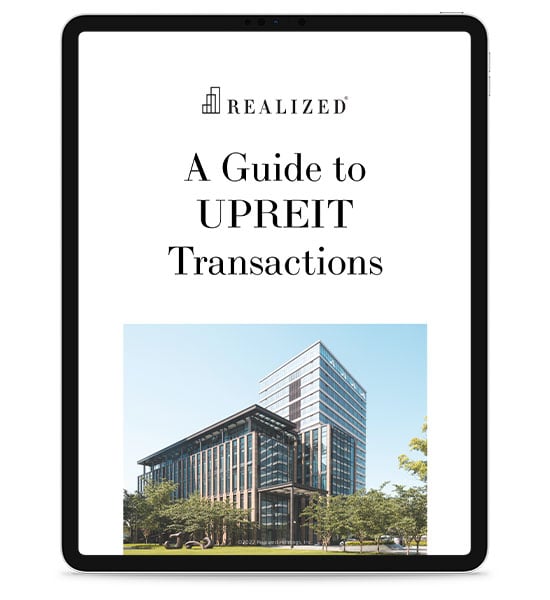
Various tax-deferred investment strategies are available to real estate investors, and two common options are direct 1031 exchanges and UPREITs. These both allow you to defer capital gains taxes under specific circumstances, but each carries distinct features, potential benefits, and limitations. Choosing the most appropriate strategy depends on your investment goals, risk tolerance, and other long-term financial objectives.
To support informed decisions, Realized 1031 has outlined a comparison of UPREITs and direct 1031 exchanges. Let’s take a closer look.
Recap of 1031 and 721 Exchanges
Both UPREITs and like-kind swaps are named from their respective Revenue Code sections: Section 721 and Section 1031. A 721 exchange allows you to contribute your real estate assets into an umbrella partnership real estate investment trust (UPREIT) in exchange for operating partnership (OP) units. Meanwhile, a 1031 exchange allows you to exchange two like-kind properties so long as both have been held for business or investment use and the transaction meets IRS requirements.
The processes for each one are intricate and distinct, but both are designed to enable the deferral of capital gains recognition when executed properly. Tax is generally triggered by a subsequent taxable event, such as the sale of the replacement property or the conversion of OP units into publicly traded REIT shares.
Pros of UPREITs
Apart from tax-deferral benefits, UPREITs offer a host of advantages that may appeal to many types of investors. Here’s what you can expect.
Passive Income
When you contribute your assets to an UPREIT, the trust assumes operational responsibilities, reducing direct involvement. Investors who want to lessen their involvement in asset management will find UPREITs to be a useful option. Unsurprisingly, UPREITs are popular among those who are nearing retirement.
More Liquidity
Compared to real property, OP units are relatively more liquid. They may be converted into REIT shares, which can be publicly traded. If liquidity is needed, this structure may offer faster access to funds than the typical real estate sale process. However, trading or selling these assets is a taxable event.
Diversification
REITs often hold multiple properties across geographic locations and real estate sectors. This structure can provide a degree of diversification not typically achievable through direct ownership of a single asset.
Professional Management
REITs are managed by real estate professionals with experience operating income-producing properties. These managers follow strategic approaches aimed at generating income and managing risk on behalf of investors.
Cons of UPREITs
The structure of UPREITs also leads to some challenges and risks, such as the following.
- Loss of Direct Control: As you contribute your property, you also lose direct control of its operations and management. This may not be ideal for investors who still want hands-on management of their assets.
- Market Risk Exposure: After conversion, OP units become publicly traded REIT shares, which are subject to equity market volatility and broader economic factors.
- Valuation Uncertainty: OP unit valuations aren’t always clear or immediate, especially pre-conversion. As such, determining the precise value of your investment can be challenging.
- Taxable Event Upon Conversion
Converting OP units into REIT shares is a taxable event. Capital gains deferred through the 721 exchange will typically be recognized at the time of conversion. - Limited Exit Flexibility
OP units are not generally liquid on demand. Conversion into REIT shares may be subject to holding periods, timing restrictions, or other limitations set by the REIT sponsor.
Pros of Direct 1031 Exchanges
Direct ownership of a replacement property, through a traditional 1031 exchange, offers the following potential advantages you may not encounter with UPREITs.
Greater Control Over Your Assets
You maintain direct ownership of the replacement asset during a delayed exchange. This benefit affords you greater decision-making authority over the management and operations of the asset. For some investors, hands-on involvement is preferable.
Custom Investment Strategy
While many UPREITs focus on generating income, some investors prioritize appreciation potential, specific geographic locations, or long-term redevelopment opportunities. Direct ownership offers flexibility to pursue a tailored strategy aligned with personal investment objectives.
Wealth Accumulation
You can continue the 1031 exchange cycle across multiple transactions, deferring capital gains taxes along the way. Upon death, heirs may receive a step-up in basis on the final replacement property, resetting its cost basis to fair market value at the time of death. This may eliminate deferred capital gains and depreciation recapture, depending on individual circumstances and applicable tax laws.
No Corporate Overhead
REIT structures typically allocate a portion of investment returns to cover corporate management and operational fees. With direct ownership, those costs may be avoided, allowing investors to retain more of the property’s net income—though ongoing property expenses still apply.
Cons of Direct 1031 Exchanges
There are also important considerations and risks you need to be aware of when owning a 1031 exchange property.
- Strict Rules and Timelines: The IRS has strict rules with regard to like-kind exchanges, including a 45-day identification period, a 180-day completion window, an equal-or-greater-value requirement, and the need for a qualified intermediary. Failing to follow any of these rules could lead to immediate tax liability.
- Active Management Burdens: Direct property ownership also means being hands-on in its management. Investors are responsible for day-to-day property operations, tenants, and maintenance.
- Single Asset Risk: Holding a single replacement property concentrates your exposure. Market downturns in the asset’s location or tenant vacancies can significantly affect cash flow and value.
721 vs. Direct 1031: Key Considerations for Investors
For most investors, the main aspect that determines the choice between UPREITs and 1031 exchanges is the desired level of involvement in property management. Both strategies allow for the deferral of capital gains taxes, and as such, examining the investor’s desire for active management versus passive ownership becomes the next most important priority.
Long-term goals such as wealth preservation and diversification may also influence the choice. UPREITs may offer easier access to a diversified pool of institutional real estate, while direct 1031 exchanges may align better with those pursuing property-specific strategies or long-term appreciation.
Final Thoughts on UPREIT vs. Direct 1031 Exchanges
Both UPREITs and direct 1031 exchanges provide potential tax deferral opportunities, but each comes with its own trade-offs. UPREITs can offer liquidity, diversification, and limited investor involvement. Direct exchanges allow for greater control, customization, and continued use of the 1031 exchange cycle. Understanding the potential advantages and risks of each approach can help investors determine which strategy aligns more closely with their individual goals, risk tolerance, and planning horizon.
The tax and estate planning information offered by the advisor is general in nature. It is provided for informational purposes only and should not be construed as legal or tax advice. Always consult an attorney or tax professional regarding your specific legal or tax situation.
Article written by: Story Amplify. Story Amplify is a marketing agency that offers services such as copywriting across industries, including financial services, real estate investment services, and miscellaneous small businesses.
Sources:
https://www.law.cornell.edu/uscode/text/26/721



